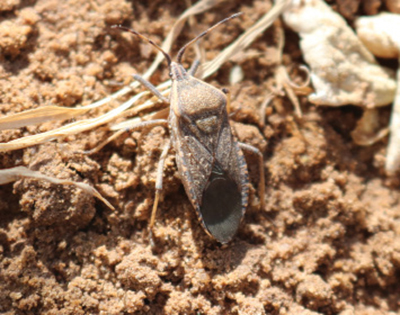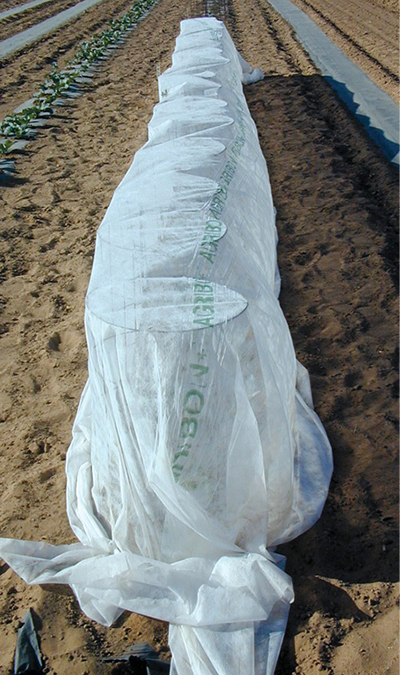Circular 655
Revised by Ashley Bennett
College of Agricultural, Consumer and Environmental Sciences, New Mexico State University
Author: Urban/Small Farm IPM Specialist, Los Lunas Agricultural Science Center, New Mexico State University. (Print Friendly PDF)
Introduction
Integrated pest management (IPM) is an approach to managing pests that seeks to limit or suppress pest populations by using a variety of compatible tactics that minimize potential harmful effects on human health and the environment. Chemical controls (e.g., insecticides) are used only as a last resort.
The concept of IPM was first developed in the late 1950s to address environmental issues caused by the overuse of chemical controls. Indiscriminate insecticide use for insect pests had led to widespread non-target effects and the development of insecticide resistance, resulting in crop failures. While IPM was originally developed to address insect problems in agricultural systems, the basic approach can be applied equally to pests in the broader sense, such as weeds, nematodes, and plant pathogens (i.e., disease-causing organisms) in smaller-scale home gardens (Figure 1 a-c).

Figure 1a. Common insect pests of New Mexico home gardens include
aphids.

Figure 1b. Common insect pests of New Mexico home gardens include
grasshoppers.

Figure 1c. Common insect pests of New Mexico home gardens include
squash bugs.
Approach
The ultimate goal of an IPM program is to keep pest populations below the level at which a pesticide is necessary. The IPM approaches used to suppress pests include cultural, biological, and physical controls. Chemical controls are used only when other measures are not adequate. The emphasis of IPM is on managing pests (i.e., keeping them within tolerable limits) rather than completely eliminating pests.
IPM begins with planning and selecting the correct plants for your landscape. Start by selecting plants that are suitable for the local environment and intended planting location. Before planting, consider the eventual height and width of the plants (particularly trees and shrubs), their preferences for soil type and pH (a measure of soil acidity), winter hardiness, light requirements (full sun versus shade), and soil moisture needs. Plants not suited to your growing conditions will always be under some degree of physiological stress, and stressed plants are much more susceptible to pest and disease problems.
Cultural Controls
The goal of cultural controls is to alter the environment or condition of the host plant to prevent or suppress pests. One of the easiest cultural IPM strategies is simply maintaining healthy plants. Proper irrigation and fertilization will minimize plant stress, making plants less susceptible to pests. Again, plant selection is important. Selecting drought-tolerant varieties if your location is hot and dry or plants resistant to insects and diseases can help prevent pest problems. The timing of planting or harvesting may help avoid pests in time and space. For example, planting sweet corn early in the growing season can limit exposure and damage by the corn earworm (Helicoverpa zea).
Cultural controls that modify the crop environment can also effectively reduce pest populations. In gardens, planting different crops each season can prevent the buildup of pests because some crops will be non-host plants and will deprive pests of their food source. Planting multiple crop species together (intercropping) increases garden diversity and can encourage beneficial insects. Trap cropping is a strategy where a pest’s preferred host is planted near the main crop, and the trap crop diverts the pest away from the main crop. This can also provide additional management options; for example, the trap crop can be destroyed along with the pest.
Some cultural controls are ideally suited for small scales such as home gardens. “Sanitation” is the removal of plant material that can harbor pests. Removing weeds, destroying crop residues, and picking up fallen fruit can eliminate overwintering and breeding sites and reduce pest populations.
Correct pruning of trees and shrubs can increase airflow and reduce humidity, making the environment less suitable for pests1. Even pruning out small areas where pests have infested trees and shrubs is an easy method of suppressing pests.
If lawns are part of your landscape, make sure that mowing heights are appropriate (setting the blades too low, for example, can create bare patches that provide sites for weed establishment)2. Be particularly careful when mowing close to trees and shrubs because mechanical injury from the mower can provide points of entry for pest insects or disease organisms.
Biological Controls
Biological control uses beneficial organisms (predators, parasitoids, and pathogens) to suppress pest populations. There are three types of biological control: 1) classical or importation, 2) augmentative, and 3) conservation.
Classical biological control involves importing, screening, and releasing natural enemies (i.e., predators and parasitoids) against introduced or non-native pests. Because introduced pests typically have no natural enemies to control their populations, a search for potential natural enemies is conducted in the pest’s country of origin. If potential biological control agents are found, federal agencies import and screen these candidates. Promising biological control agents are then released with the hope that they become permanently establish. While classical biological control has been very successful against some non-native pests, a disadvantage of this strategy is if imported natural enemies are not carefully screened they can attack and reduce populations of native species.
Augmentative biological control typically involves the purchase and release of large numbers of natural enemies. There are two types of augmentative biological control: inundative and inoculative releases. An inundative release is a single mass where natural enemies are expected to overwhelm the pest population, but not expected to establish or reproduce. An inoculative release involves several small releases of natural enemies where natural enemies are expected to establish, spread, and provide continual pest suppression.
The goal of conservation biological control is to augment existing beneficial insect populations by manipulating the environment to favor natural enemies. For example, incorporating flowers into the landscape can provide needed food resources (e.g., pollen and nectar), overwintering habitat, and alternative sources of prey. Reducing factors that can limit natural enemy effectiveness is also important, such as decreasing pesticide applications that directly kill natural enemies, reducing host availability, and eliminating pollen and nectar resources by removing weedy species.
When implementing conservation biological control, identifying natural enemies is important for improving effectiveness. Insect natural enemies include both predators and parasitoids. Some key predatory insects include ladybird beetles (“ladybugs”), lacewings, ground beetles, rove beetles, big-eyed bugs, pirate bugs, and hover flies. Equally important, but often less visible, are the parasitoids—various species of wasps and flies that lay their eggs on or in the body of a host insect. When the eggs hatch, the developing parasitoid larva feeds on the internal tissues of the host until the host dies. At that point, the parasitoid larva usually pupates inside the dead host, and eventually a new adult parasitoid emerges. Parasitoids tend to be more restricted than predators in the number of different insects that they can successfully attack, but nevertheless can be very effective biological control agents.
In home gardens, conservation biological control strategies often include habitat management. Encourage natural enemies by diversifying your landscape to include a variety of flowering plants. The adult stages of many beneficial insects benefit from having access to nectar and/or pollen, which can extend their lifespan and reproductive output, or, in some cases, sustain them when prey is scarce. Since beneficial insects differ widely in size and in their preferences for different flowers, it helps to grow a mixture of flowering species to provide a variety of flower shapes, sizes, and blooming periods3. To maximize the abundance and diversity of natural enemies in backyard gardens, provide flowering resources across the growing season and try to eliminate pesticide exposure.
Larger predators, such as birds, are also important predators of insect pests. If sufficient space is available, consider installing nest boxes to encourage these predators. Both birds and beneficial insects will also benefit from a regular supply of fresh water, but remember to empty and clean out the container every few days to prevent the development of mosquito larvae.
In enclosed or partially enclosed situations, such as greenhouses and hoop houses, you may want to consider buying and releasing beneficial insects from a commercial insectary company. If the correct natural enemies are selected and the releases are done early enough (i.e., as soon as developing pest problems are detected and before their populations become too high), this approach can be very effective.
Mechanical and Physical Controls
The goal of mechanical controls is to use machines to directly remove or reduce pests by altering their environment. While some mechanical controls are more applicable to conventional agriculture, most are appropriate for home gardens. For example, hand-removal of pests, though laborious, can be effective on a small scale (e.g., with bagworms or squash bug egg masses). Tilling garden soils in the fall can expose overwintering eggs and larva to drying out, cold temperatures, and being eaten by birds. Finally, a strong spray of water can dislodge insects like aphids and mites from small trees, shrubs, and garden plants.
Physical controls work to exclude pests, preventing them from reaching their hosts. Physical controls, such as netting, screens, and floating row covers, can protect newly emerged seedlings or transplants before they are colonized by pest insects. This technique is most commonly used to protect vegetable crops from either direct pests or the vectors of plant pathogens (e.g., to protect brassicas from flea beetles, or to protect tomatoes from the beet leafhopper which can transmit curly top virus) (Figure 2). Row covers can be very effective, but care must be taken to ensure no pests are present before the covers are installed, no holes are present in the covers, and a good seal is maintained between the soil and the edges of the covers. For crops that require insect pollination, the covers must be removed once flowers are produced.

Figure 2. Floating row covers used to protect newly transplanted tomato plants from beet leafhopper (vector of curly top virus).
Traps are another physical control suitable for use in small-scale gardens and greenhouses. Traps can be baited, meaning they contain pheromones to attract pests, or unbaited. Unbaited traps are often brightly colored and covered in glue. Yellow sticky cards are an example of an unbaited trap and will attract and capture a variety of greenhouse pests (e.g., thrips, whiteflies, and fungus gnats). Apple maggot flies are another pest that can be suppressed using traps. Traps are commercially available as baited or unbaited red spheres, which are covered in glue. Traps must be replaced when the surface becomes saturated with either insects or wind-blown soil particles. Unfortunately, the yellow surface of sticky cards is also attractive to various beneficial insects, so avoid this technique when releasing biological control agents into the greenhouse. Corrugated cardboard bands wrapped around the base of trees can be used to trap codling moth larva as they search for locations to pupate and overwinter. The following spring before moths emerge, bands should be removed and destroyed.
Monitoring
In commercial situations, IPM usually includes a regularly scheduled program of pest monitoring together with formal treatment thresholds (also known as “action thresholds”). Application of insecticides is limited to situations where the pest population reaches the recommended treatment threshold. In a home garden, however, treatment thresholds for specific plants and pests may not be available, and pest monitoring (while still very important) tends to be more informal and less intensive.
In home gardens, monitoring for pests and beneficials can simply involve regular visual inspection of plants while carrying out other garden chores. If a pest is detected visually, inspect garden plants weekly to determine whether pest populations are increasing over time. To quantify pest populations, select a random number of plant leaves to visually count insect pests, record counts, and repeat weekly. If counts are decreasing or staying the same, no action is required. However, if insect numbers are increasing then consider implementing an IPM practice to suppress population growth and minimize damage.
With insect pests, feeding damage is often more noticeable than the insect itself. Many chewing insects feed in very characteristic ways that can help with diagnosis (e.g., flea beetles create small, circular “shot holes,” while adult vine weevils cut semi-circular notches in the edges of leaves). The presence of sap-sucking pests (e.g., aphids, scale insects, whiteflies, and mealybugs) is often first noticed by the presence of a sticky coating of “honeydew” on the surface of the leaves. This sugary waste product is excreted as the insects feed and typically falls on the leaves underneath the insect colony. By examining the underside of leaves above the honeydew, you can often identify the insects responsible. If the honeydew is not washed off by rain, it may become covered by black “sooty mold”; although this fungus is unsightly, it only damages the plant indirectly by reducing the amount of light reaching the leaves. Both honeydew and sooty mold can be washed off with water.
In addition to visual inspections, more formal methods of monitoring include the use of traps (e.g., yellow sticky cards, pheromone traps, etc.). These are used for particular pests or situations. Consult your local county Extension office (https://aces.nmsu.edu/county/) for guidance on using traps in relation to specific pests.
Insecticides
Insecticides must be chosen and applied with care. Ideally, use a selective product, one that will kill the pest while preserving beneficial insects. Unfortunately, few such products are available for use by home gardeners. Most of the commonly available products are broad spectrum in nature and kill both pest insects and their natural enemies. In some cases, this can cause secondary pest outbreaks, where spraying for one pest creates “new” pest problems through the destruction of predators and/or parasitoids that were keeping other pest species under control.
Before proceeding with an insecticide application, double-check that you have correctly identified the pest (otherwise your control tactics are likely to fail), the insect is in the correct stage for treatment (some stages are easier to kill than others), and the product you plan to use is registered for the intended purpose in New Mexico. If in doubt, contact the New Mexico Department of Agriculture (https://www.nmda.nmsu.edu/pesticides/). Remember that it is illegal to apply any pesticide in a manner that does not follow the directions and instructions given on the product label.
References
Cranshaw, W. 1998. Pests of the West: Prevention and control for today’s garden and small farm. Golden, CO: Fulcrum Publishing.
Cranshaw, W. 2004. Garden insects of North America: The ultimate guide to backyard bugs. Princeton, NJ: Princeton University Press.
Ellis, B.W., and F.M. Bradley (Eds.). 1996. The organic gardener’s handbook of natural insect and disease control: A complete problem-solving guide to keeping your garden and yard healthy without chemicals. Emmaus, PA: Rodale Books.
Evans, A.V. 2007. National Wildlife Federation field guide to insects and spiders & related species of North America. New York: Sterling.
Landis, D.A., S.D. Wratten, and G.M. Gurr. 2000. Habitat management to conserve natural enemies of arthropod pests. Annual review of Entomology, 45, 175–201.
Lee-Mäder, E., J. Hopwood, L. Morandin, M. Vaughan, and S.H. Black (Eds.). 2014. Farming with native beneficial insects: ecological pest control solutions. North Adams, MA: Storey Publishing.
Mader, E., M. Shepherd, M. Vaughan, S.H. Black, and G. LeBuhn (Eds.). 2011. Attracting native pollinators: Protecting North America’s bees and butterflies. North Adams, MA: Storey Publishing.
Footnotes
1 See NMSU Cooperative Extension Guide H-156, Tree Pruning Techniques (https://pubs.nmsu.edu/_h/H156/).
2 See NMSU Cooperative Extension Guide H-505, Mowing Your Lawn (https://pubs.nmsu.edu/_h/H505/).
3 For more information, see Pocket Guide to the Beneficial Insects of New Mexico (https://pubs.nmsu.edu/insects/).
For further reading
H-106: Curly Top Virus
https://pubs.nmsu.edu/_h/H106/
H-168: Selection and Use of Insecticides for Organic Production
https://pubs.nmsu.edu/_h/H168/
H-169: Using Insectary Plants to Attract and Sustain Beneficial Insects for Biological Pest Control
https://pubs.nmsu.edu/_h/H169/
Original author: Tessa R. Grasswitz, Urban/Small Farm IPM Specialist.

Ashley Bennett is the Urban and Small Farm IPM Specialist at NMSU. She earned her Ph.D. in entomology from the University of Wisconsin. Her research focuses on improving the design of urban and agricultural landscapes to conserve beneficial insects and increase their ecosystem services, including developing native plant mixes to support beneficial insects, improving site selection for urban agriculture, and using drone technology to improve IPM.
To find more resources for your business, home, or family, visit the College of Agricultural, Consumer and Environmental Sciences on the World Wide Web at pubs.nmsu.edu
Contents of publications may be freely reproduced for educational purposes. All other rights reserved. For permission to use publications for other purposes, contact pubs@nmsu.edu or the authors listed on the publication.
New Mexico State University is an equal opportunity/affirmative action employer and educator. NMSU and the U.S. Department of Agriculture cooperating.
Revised October 2017 Las Cruces, NM


